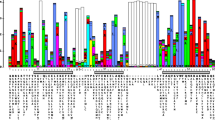Abstract
The Popeye domain-containing gene family has been isolated on the basis of a subtractive screen aiming at the identification of novel genes with a heart-restricted gene expression pattern. The gene family codes for membrane proteins containing three transmembrane domains. The carboxy-terminal part of the protein is localized to the cytoplasm and contains a protein domain with high sequence conservation named the Popeye domain. This domain is involved in protein homo-dimerization. The gene family is expressed in heart and skeletal muscle cells as well as smooth muscle cells. In addition, Popdc genes are expressed in other cell types such as neuronal cells in restricted areas of the brain, spinal cord, and dorsal root ganglia, and in various epithelial cells. Recently, it has been proposed that Popdc proteins may function as a novel family of adhesion proteins. That the expression pattern has been conserved during evolution and is very similar in all vertebrate classes and also in basal chordates suggests that Popdc proteins play an important role in cardiac and skeletal muscle.
Similar content being viewed by others
References
Brand, T. (2003) Heart development: molecular insights into cardiac specification and early morphogenesis. Dev. Biol. 258, 1–19.
Andrée, B., Hillemann, T., Kessler-Icekson, G., et al. (2000) Isolation and characterization of the novel popeye gene family expressed in skeletal muscle and heart. Dev. Biol. 223, 371–382.
Reese, D. E., Zavaljevski, M., Streiff, N. L., and Bader, D. (1999) bves: a novel gene expressed during coronary blood vessel development. Dev. Biol. 209, 159–171.
Hitz, M. P., Pandur, P., Brand, T., and Kuhl, M. (2002) Cardiac specific expression of Xenopus Popeye-1. Mech. Dev. 115, 123–126.
Ripley, A. (2004) Bves function in epithelial movement during development. (Dissertation) Vanderbilt University, Nashville, TN.
Davidson, B. and Levine, M. (2003) Evolutionary origins of the vertebrate heart: specification of the cardiac lineage in Ciona intestinalis. Proc. Natl. Acad. Sci. USA 100, 11,469–11,473.
Davidson, B., Smith Wallace, S. E., Howsmon, R. A., and Swalla, B. J. (2003) A morphological and genetic characterization of metamorphosis in the ascidian Boltenia villosa. Dev. Genes Evol. 213, 601–611.
Lin, S., Zhao, D., and Bownes, M. (2002). The function of a novel gene (Z14/Dmbves) in Drosophila oogenesis, 43rd Annual Drosophila Research Conference. California.
Breher, S. S., Mavridou, E., Brenneis, C., Froese, A., Arnold, H. H., and Brand, T. (2004) Popeye domain containing gene 2 (Popdc2) is a myocyte-specific differentiation marker during chick heart development. Dev. Dyn. 229, 695–702.
Wada, A. M., Smith, T. K., Osler, M. E., Reese, D. E., and Bader, D. M. (2003) Epicardial/mesothelial cell line retains vasculogenic potential of embryonic epicardium. Circ. Res. 92, 525–531.
Osler, M. E. and Bader, D. M. (2004) Bves expression during avian embryogenesis. Dev. Dyn. 229, 658–667.
Vasavada, T. K., DiAngelo, J. R., and Duncan, M. K. (2004) Developmental expression of Pop1/Bves. J. Histochem. Cytochem. 52, 371–377.
DiAngelo, J. R., Vasavada, T. K., Cain, W., and Duncan, M. K. (2001) Production of monoclonal antibodies against chicken Pop1 (BVES). Hybrid Hybridomics 20, 377–381.
Andrée, B., Fleige, A., Arnold, H. H., and Brand, T. (2002) Mouse Pop1 is required for muscle regeneration in adult skeletal muscle. Mol. Cell. Biol. 22, 1504–1512.
Knight, R. F., Bader, D. M., and Backstrom, J. R. (2003) Membrane topology of Bves/Pop1A, a cell adhesion molecule that displays dynamic changes in cellular distribution during development. J. Biol. Chem. 278, 32,872–32,879.
Wada, A., Reese, D., and Bader, D. (2001) Bves: prototype of a new class of cell adhesion molecules expressed during coronary artery development. Development 128, 2085–2093.
Barber, T. D., Barber, M. C., Tomescu, O., Barr, F. G., Ruben, S., and Friedman, T. B. (2002) Identification of target genes regulated by PAX3 and PAX3-FKHR in embryogenesis and alveolar rhabdomyosarcoma. Genomics 79, 278–284.
Smith, T. K., Osler, M. E., and Bader, D. M. (2004) Role of Bves in development of the myocardium, Weinstein Symposium 2004, Leiden, The Netherlands.
Ripley, A. N., Chang, M. S., and Bader, D. M. (2004) Bves is expressed in the epithelial components of the retina, lens, and cornea. Invest. Ophthalmol. Vis. Sci. 45, 2475–2483.
Author information
Authors and Affiliations
Corresponding author
Rights and permissions
About this article
Cite this article
Brand, T. The Popeye domain-containing gene family. Cell Biochem Biophys 43, 95–103 (2005). https://doi.org/10.1385/CBB:43:1:095
Issue Date:
DOI: https://doi.org/10.1385/CBB:43:1:095




